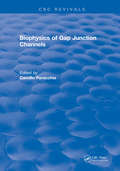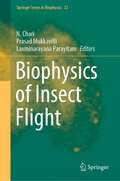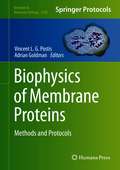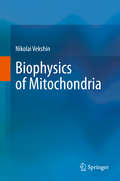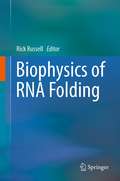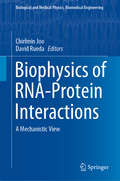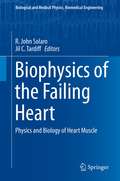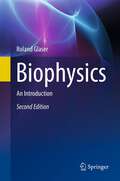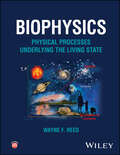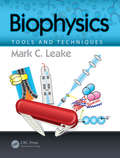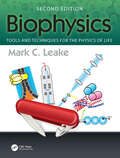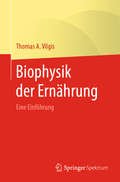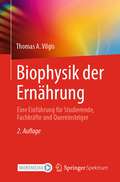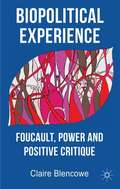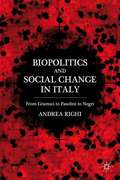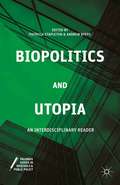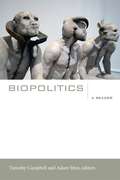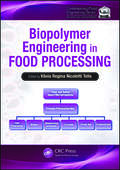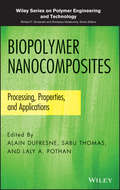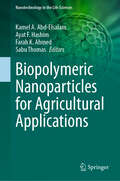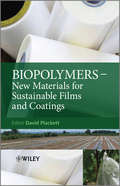- Table View
- List View
Biophysics of Gap Junction Channels
by M.D. PeracchiaThis book provides a state of the art account of present knowledge of the biophysics of cell-to-cell channels. It is divided into two sections, one dealing with two-cell systems and the other with reconstitution systems.
Biophysics of Insect Flight (Springer Series in Biophysics #22)
by N. Chari Prasad Mukkavilli Laxminarayana ParayitamThis book basically involves the study of flight parameters, wing beat frequency, moment of inertia, and wing movements for developing various aerodynamic forces which have been calculated. The book is intended for biologists, physicists, nanotechnologists, and aerospace engineers. Resilin, an elastic polymer (4 λ) which is present at the base of insect, plays a major role in Neurogenic and Myogenic insect flyers and influences the physiology of flight muscles. Leading edge vortex (LEV) is a special feature of insect flight. Insect wings have stalling angle above 60 degrees as compared to a man-made aeroplane stalling angle which is 16 degree. Reynolds number, the knowledge of LEV, and detailed study of moment of inertia help in developing flapping flexible wings for micro-aerial-vehicles. This book serves as an interface between biologists and engineers interested to develop biomimicking micro-aerial-vehicles. The contents of this book is useful to researchers and professionals alike.
Biophysics of Membrane Proteins: Methods and Protocols (Methods in Molecular Biology #2168)
by Adrian Goldman Vincent L. G. PostisThis volume provides recent advances in the field of biophysics of membrane proteins. Chapters are divided into several parts: detailing biochemistry and functional analysis, experimental and theoretical structural determinations, membrane protein dynamics, and conformation studies. Written in the highly successful Methods in Molecular Biology series format, chapters include introductions to their respective topics, lists of the necessary materials and reagents, step-by-step, readily reproducible laboratory protocols, and tips on troubleshooting and avoiding known pitfalls.Authoritative and cutting-edge, Biophysics of Membrane Proteins: Methods and Protocols aims to provide comprehensive protocols with notes to help further the understanding of key membrane protein structure and function for students, academics, and industrial researchers.
Biophysics of Mitochondria
by Nikolai VekshinIn this monograph, the author -Head researcher at the Institute of Cell Biophysics of Russian Academy of Sciences- discusses the results of his own long-term studies of mitochondria as well as alternative points of view and experiments of other important researchers in the field. The monograph contains the main aspects of mitochondrial research by a number of physical methods: fluorescence spectroscopy, UV-vis spectrophotometry, IR spectroscopy, light-scattering, optical microscopy, fluorescence microscopy, colorimetry, photobleaching, polarography, among others. The monograph is very useful for researchers and graduate students specializing in mitochondrial biophysics, biochemistry, molecular biology and cytology. The book was published in Russian in 2019 by Photon Publishers (Pushchino, Moscow region).
Biophysics of RNA Folding (Biophysics for the Life Sciences #3)
by Rick RussellThis volume, written by experts in the field, discusses the current understanding of the biophysical principles that govern RNA folding, with featured RNAs including the ribosomal RNAs, viral RNAs, and self-splicing introns. In addition to the fundamental features of RNA folding, the central experimental and computational approaches in the field are presented with an emphasis on their individual strengths and limitations, and how they can be combined to be more powerful than any method alone; these approaches include NMR, single molecule fluorescence, site-directed spin labeling, structure mapping, comparative sequence analysis, graph theory, course-grained 3D modeling, and more. This volume will be of interest to professional researchers and advanced students entering the field of RNA folding.
Biophysics of RNA-Protein Interactions: A Mechanistic View (Biological and Medical Physics, Biomedical Engineering)
by David Rueda Chirlmin JooRNA molecules play key roles in all aspects of cellular life, but to do so efficiently, they must work in synergism with proteins. This book addresses how proteins and RNA interact to carry out biological functions such as protein synthesis, regulation of gene expression, genome defense, liquid phase separation and more.The topics addressed in this volume will appeal to researchers in biophysics, biochemistry and structural biology. The book is a useful resource for anybody interested in elucidating the molecular mechanisms and discrete properties of RNA-protein complexes. Included are reviews of key systems such as microRNA and CRISPR/Cas that exemplify how RNA and proteins work together to perform their biological function. Also covered are techniques ranging from single molecule fluorescence and force spectroscopy to crystallography, cryo-EM microscopy, and kinetic modeling.
Biophysics of the Failing Heart: Physics and Biology of Heart Muscle (Biological and Medical Physics, Biomedical Engineering)
by Jil C. Tardiff R. John SolaroSubjects in the monograph "Biophysics of the Failing Heart" include state of the art chapters considering major biophysical mechanisms for why hearts responding to acquired or inherited stressors enter into maladaptive processes eventually leading to an inability of the heart to respond efficiently to hemodynamic loads especially during exercise. The chapters describe biophysical techniques that have been applied to determine the triggers for the heart failure process as well as the mechanisms for sustaining the disorders. These techniques include measurements of active and passive mechanical properties and hemodynamics at levels of organization ranging from molecules to hearts beating in situ. Biophysical concepts and approaches are also applied to determination of signaling and signal transduction, energetics, ionic currents, transport processes, electro-chemical and chemo-mechanical coupling. By its emphasis on biophysical aspects of a prevalent clinical condition, the monograph is unique in its perspective and focus. The breadth of information in the chapters all in one place will be of value to clinicians and researchers at all levels. Modern research approaches and clinical understanding of heart failure demands integration of multiple aspects of the disorders. In most cases, combinations of clinician scientists and researchers author the chapters. A main benefit of the book is couched in its didactic approach together with its emphasis on how biophysical concepts and techniques aid in diagnosis and development of new therapies.
Biophysics: A Student’s Guide to the Physics of the Life Sciences and Medicine
by William C. ParkeThis comprehensive and extensively classroom-tested biophysics textbook is a complete introduction to the physical principles underlying biological processes and their applications to the life sciences and medicine. The foundations of natural processes are placed on a firm footing before showing how their consequences can be explored in a wide range of biosystems. The goal is to develop the readers’ intuition, understanding, and facility for creative analysis that are frequently required to grapple with problems involving complex living organisms. Topics cover all scales, encompassing the application of statics, fluid dynamics, acoustics, electromagnetism, light, radiation physics, thermodynamics, statistical physics, quantum biophysics, and theories of information, ordering, and evolutionary optimization to biological processes and bio-relevant technological implementations. Sound modeling principles are emphasized throughout, placing all the concepts within a rigorous framework. With numerous worked examples and exercises to test and enhance the reader’s understanding, this book can be used as a textbook for physics graduate students and as a supplementary text for a range of premedical, biomedical, and biophysics courses at the undergraduate and graduate levels. It will also be a useful reference for biologists, physicists, medical researchers, and medical device engineers who want to work from first principles.
Biophysics: An Introduction (Springer Series In Biophysics Ser. #5)
by Roland GlaserBiophysics is the science of physical principles underlying all processes of life, including the dynamics and kinetics of biological systems.This fully revised 2nd English edition is an introductory text that spans all steps of biological organization, from the molecular, to the organism level, as well as influences of environmental factors. In response to the enormous progress recently made, especially in theoretical and molecular biophysics, the author has updated the text, integrating new results and developments concerning protein folding and dynamics, molecular aspects of membrane assembly and transport, noise-enhanced processes, and photo-biophysics. The advances made in theoretical biology in the last decade call for a fully new conception of the corresponding sections. Thus, the book provides the background needed for fundamental training in biophysics and, in addition, offers a great deal of advanced biophysical knowledge.
Biophysics: Physical Processes Underlying the Living State
by Wayne F. ReedAn introduction to the physics of living organisms The field of biophysics employs the principles of physics to study biological systems, and introduces the concept of the living state. It is a multidisciplinary approach to the study of the living state combining physics, biochemistry, molecular and cell biology, medicine and engineering. The physics of macromolecules and macromolecular assemblies is a particularly important aspect of this broader field. Biophysics: Physical Processes Underlying the living state offers an introduction to the general principles of the living state and their biological applications. Beginning with an historical overview of fundamental scientific theories and fields, the book then provides a brief introduction to cell biology and biochemistry, and then an overview of basic thermodynamics, kinetics, information theory, electrostatics in solution, fluid mechanics and macromolecular physics, and their relationship to the living state. After a presentation of physical methods, with an emphasis on light scattering, different biological macromolecules, selected aspects of their functions, and their physical properties and interactions are surveyed. A brief introduction to vision, biomotion, and theoretical biology is also provided. Exploration of some frontier issues in prebiotic origins of life, consciousness, and astrobiology round out the book. The result is a multifaceted window into the broad and evolving field of biophysics. Biophysics readers will also find: Problems at the conclusion of each chapter to reinforce and focus student knowledgeA gathering of topics in basic physics and physical chemistry which are seldom found in a single source This textbook is suitable for physics and engineering students studying biophysics, macromolecular science, and biophysical chemistry, as well as for polymer scientists, chemists, biochemists, cell and molecular biologists, bioengineers, and others.
Biophysics: Tools and Techniques
by Mark C. LeakeAn Up-to-Date Toolbox for Probing Biology Biophysics: Tools and Techniques covers the experimental and theoretical tools and techniques of biophysics. It addresses the purpose, science, and application of all physical science instrumentation and analysis methods used in current research labs. The book first presents the historical background, concepts, and motivation for using a physical science toolbox to understand biology. It then familiarizes undergraduate students from the physical sciences with essential biological knowledge. The text subsequently focuses on experimental biophysical techniques that primarily detect biological components or measure/control biological forces. The author describes the science and application of key tools used in imaging, detection, general quantitation, and biomolecular interaction studies, which span multiple length and time scales of biological processes both in the test tube and in the living organism. Moving on to theoretical biophysics tools, the book presents computational and analytical mathematical methods for tackling challenging biological questions including exam-style questions at the end of each chapter as well as step-by-step solved exercises. It concludes with a discussion of the future of this exciting field. Future innovators will need to be trained in multidisciplinary science to be successful in industry, academia, and government support agencies. Addressing this challenge, this textbook educates future leaders on the development and application of novel physical science approaches to solve complex problems linked to biological questions. Features: Provides the full, modern physical science toolbox of experimental and analytical techniques, such as bulk ensemble methods, single-molecule tools, and live-cell and test tube methods Incorporates worked examples for the most popular physical science tools, including full diagrams and a summary of the science involved in the application of the tool Reinforces the understanding of key concepts and biological questions A solutions manual is available upon qualifying course adoption.
Biophysics: Tools and Techniques for the Physics of Life
by Mark C. LeakeBiophysics: Tools and Techniques for the Physics of Life covers the experimental, theoretical, and computational tools and techniques of biophysics. It addresses the purpose, science, and application of all physical science instrumentation, theoretical analysis, and biophysical computational methods used in current research labs. The book first presents the historical background, concepts, and motivation for using a physical science toolbox to understand biology. It then familiarizes undergraduate students from the physical sciences with essential biological knowledge. The text subsequently focuses on experimental biophysical techniques that primarily detect biological components or measure/control biological forces. The author describes the science and application of key tools used in imaging, detection, general quantitation, and biomolecular interaction studies, which span multiple length and time scales of biological processes both in the test tube and in the living organism. Moving on to theoretical and computational biophysics tools, the book presents analytical mathematical methods and numerical simulation approaches for tackling challenging biological questions including exam-style questions at the end of each chapter as well as step-by-step solved exercises. It concludes with a discussion of the future of this exciting field. Future innovators will need to be trained in multidisciplinary science to be successful in industry, academia, and government support agencies. Addressing this challenge, this textbook educates future leaders on the development and application of novel physical science approaches to solve complex problems linked to biological questions. Features: Provides the full, modern physical science toolbox of experimental, theoretical, and computational techniques, such as bulk ensemble methods, single-molecule tools, live-cell and test tube methods, pencil-on-paper theory approaches, and simulations. Incorporates worked examples for the most popular physical science tools by providing full diagrams and a summary of the science involved in the application of the tool. Reinforces the understanding of key concepts and biological questions. A solutions manual is available upon qualifying course adoption.
Biophysik der Ernährung: Eine Einführung
by Thomas A. VilgisVerstehen Sie die unzähligen, widersprüchlichen Ernährungsempfehlungen nicht mehr? Können Sie beim Cholesterin nur ganz schwer zwischen Gut und Böse unterscheiden? Verstehen Sie nicht, warum 12 Nüsse pro Tag gut für Ihr Herz und Kreislauf sein sollen? Sind Sie hin- und hergerissen zwischen verschiedenen Ernährungsregeln und Ernährungsformen, die täglich auf Sie hereinprasseln, und verzweifeln am Begriff „gesunde Ernährung“? Oder sind Sie beruflich, z. B. als Berater oder Fitnesscoach, mit Fragen rund um Ernährung konfrontiert und möchten sich die naturwissenschaftlichen Grundlagen aneignen? Der Autor Thomas Vilgis rät, dabei erst einmal gelassen zu bleiben und sachlich über alle Mutmaßungen, Vermutungen, Versprechen, Orientierungsvorschläge nachzudenken.Das Buch führt Sie abseits ausgetretener Pfade und mit naturwissenschaftlicher, nüchterner Sicht an grundsätzliche Fragen der Ernährung heran. Ausgehend von der Ernährungsgeschichte des Homo sapiens begleitet Sie der Autor in das grundlegende Zusammenspiel zwischen Proteinen, Fetten und Kohlenhydraten, was sie im Körper bewirken, wie sie verdaut werden und welche Rolle sie wirklich spielen. So zeigt sich rasch, wie wenig sich hinter manchen zweifelhaften Aussagen verbirgt. Mit dem Anspruch einer ideologiefreien, molekularen Sicht auf die Ernährung gelingt es, auf verständliche und unterhaltsame Weise so manche fragwürdige Empfehlung zur Ernährung zu relativieren und zu entlarven.
Biophysik der Ernährung: Eine Einführung für Studierende, Fachkräfte und Quereinsteiger
by Thomas A. VilgisVerstehen Sie die unzähligen, widersprüchlichen Ernährungsempfehlungen nicht mehr? Können Sie beim Cholesterin nur ganz schwer zwischen Gut und Böse unterscheiden? Sind Sie hin- und hergerissen zwischen verschiedenen Ernährungsregeln und Ernährungsformen, die täglich auf Sie hereinprasseln, und verzweifeln am Begriff „gesunde Ernährung“? Oder sind Sie beruflich, z. B. als Berater oder Fitnesscoach, mit Fragen zum Thema Ernährung konfrontiert und möchten sich die naturwissenschaftlichen Grundlagen aneignen? Der Autor Thomas Vilgis rät, dabei erst einmal gelassen zu bleiben und sachlich über alle Mutmaßungen, Vermutungen, Versprechen und Orientierungsvorschläge nachzudenken.Dieses Buch führt Sie abseits ausgetretener Pfade und mit naturwissenschaftlicher, nüchterner Sicht an grundsätzliche Fragen der Ernährung heran. Ausgehend von der Ernährungsgeschichte des Homo sapiens begleitet Sie der Autor in das grundlegende Zusammenspiel zwischen Proteinen, Fetten und Kohlenhydraten, was sie im Körper bewirken, wie sie verdaut werden und welche Rolle sie wirklich spielen. Unterstützend finden Sie in der zweiten Auflage verschiedene abrufbare Videos, in denen komplexe Zusammenhänge anschaulich erklärt werden. So zeigt sich rasch, wie wenig sich hinter manchen zweifelhaften Aussagen verbirgt. Mit dem Anspruch einer naturwissenschaftlichen und molekularen Sicht auf die Ernährung gelingt es, auf verständliche und unterhaltsame Weise so manche fragwürdige Empfehlung zur Ernährung zu relativieren und einzuordnen.
Biophysik in der Zelle
by Hendrik Dietz Thomas BornschlöglDieses Lehrbuch richtet sich an alle Studierenden der Naturwissenschaften, die einen Einblick in die physikalische Beschreibung grundlegender zellulärer Prozesse suchen. Unter anderem werden die Phänomene der Diffusion und die Mechanik von Makromolekülen behandelt und an vielen Beispielen illustriert. Weiter werden die Bildung der Faserproteine des Zytoskeletts, die mechanischen Eigenschaften der Lipidmembran der Zelle sowie die Enzymkinetik und die Funktionsweise molekularer Motoren besprochen. <P><P> Dieses kompakte Buch baut auf einer zweisemestrigen Vorlesung mit dem Titel Biophysik in der Zelle auf, die an der Technischen Universität München gehalten wird. Um unterschiedliche Herangehensweisen zu unterstreichen und damit verständlicher zu gestalten, werden wichtige Formeln oft auf verschiedenen Wegen hergeleitet. „Übrigens“-Abschnitte, in denen historische oder aktuelle Hintergründe und der wissenschaftliche Zeitgeist der jeweiligen Forschung beleuchtet werden, reichern den Stoff kurzweilig an. Ansprechende, klare und moderne Abbildungen geben dem Buch neben dem fachlich aktuellen und verständlich dargestellten Inhalt einen besonderen Charme.
Biophysik in der Zelle: Für angehende Naturwissenschaftler
by Hendrik Dietz Thomas BornschlöglDieses Lehrbuch richtet sich an alle Studierenden der Naturwissenschaften, die einen Einblick in die physikalische Beschreibung grundlegender zellulärer Prozesse suchen. Unter anderem werden die Phänomene der Diffusion und die Mechanik von Makromolekülen behandelt und an vielen Beispielen illustriert. Weiter werden die Bildung der Faserproteine des Zytoskeletts, die mechanischen Eigenschaften der Lipidmembran der Zelle sowie die Enzymkinetik und die Funktionsweise molekularer Motoren besprochen. Dieses kompakte Buch baut auf einer zweisemestrigen Vorlesung mit dem Titel Biophysik in der Zelle auf, die an der Technischen Universität München gehalten wird. Um unterschiedliche Herangehensweisen zu unterstreichen und damit verständlicher zu gestalten, werden wichtige Formeln oft auf verschiedenen Wegen hergeleitet. „Übrigens“-Abschnitte, in denen historische oder aktuelle Hintergründe und der wissenschaftliche Zeitgeist der jeweiligen Forschung beleuchtet werden, reichern den Stoff kurzweilig an. Ansprechende, klare und moderne Abbildungen geben dem Buch neben dem fachlich aktuellen und verständlich dargestellten Inhalt einen besonderen Charme. Aus dem Inhalt: - Entstehung und Aufbau von Zellen, grundlegende Begriffe der Biophysik und wichtige Grundlagen der Thermodynamik und statistischen Mechanik - Passive Bewegung durch Diffusion: Physikalische Beschreibung der Diffusion, Gittermodelle, Diffusion in einem Potential, biochemische Reaktionen - Mechanik von Balken, Polymeren und Membranen: Elastische Eigenschaften biologischer Bauelemente, Kräfte, Biegen, Dehnen, Strecken und Reißen der Zellmembran und des Zytoskeletts. - Aktive Bewegung und Enzymkinetik: Funktionsweise von Enzymen, molekulare Motoren und die Dynamik der Faserproteine im Zytoskelett
Bioplastics for Sustainable Development
by Mohammed Kuddus RoohiThis book provides the latest information on bioplastics and biodegradable plastics. The initial chapters introduce readers to the various sources and substrates for the synthesis of bioplastics and biodegradable plastics, and explain their general structure, physio-chemical properties and classification.In turn, the book discusses innovative methods for the production of bioplastics at the industrial level and for the microbial production of bioplastics. It highlights the processes that are involved in the conversion of agro-industrial waste into bioplastics, while also summarizing the mechanisms of biodegradation in bioplastics.The book addresses a range of biotechnological applications of bioplastics such as in agriculture, food packaging and pharmaceutical industry, as well as biomedical applications.
Biopolitical Experience
by Claire BlencoweAn original, comprehensive interpretation of Michel Foucault's analysis of biopolitics situating biopolitics in the context of embodied histories of subjectivity, affective investments and structures of experience. Going beyond lamentation at the horrors of biopolitical domination, the book develops a positive-critique of biopolitical experience. "
Biopolitics and Social Change in Italy
by Andrea RighiThe study of how life can be controlled, supported, and manipulated has become the most urgent scientific and political task of our society. By placing the social dimension of labor at the base of the discourse of life, this book engages with the work of key intellectual figures including Gramsci, Pasolini, the neo-feminist militants of Lotta Femminista, Negri, and Virno, and reconstructs a critical genealogy of the notion of biopolitics from the point of view of twentieth and twenty-first century Italy. "
Biopolitics and Utopia: An Interdisciplinary Reader (Palgrave Series in Bioethics and Public Policy)
by Patricia Stapleton Andrew ByersThis interdisciplinary reader offers a fascinating exploration of the intersection of biopolitics and utopia by employing a range of theoretical approaches. Each essay provides a unique application of the two concepts to topics spanning the social sciences and humanities.
Biopolitics: A Reader
by Adam Sitze Timothy CampbellThis anthology collects the texts that defined the concept of biopolitics that has become so significant throughout the humanities and social sciences today. The far-reaching influence of the biopolitical - the relation of politics to life, or the state to the body - is not surprising given its centrality to matters such as healthcare, abortion, immigration, and the global distribution of essential medicines and medical technologies.
Biopolymer Engineering in Food Processing (Contemporary Food Engineering)
by Vnia Regina Nicoletti TelisDue to their unique properties and ability to interact with other food components, biopolymers have traditionally played a major role in food processing. Biopolymer Engineering in Food Processing explores processing technology associated with biopolymer applications and discusses both operational and economic aspects.Following an overview of biopol
Biopolymer Nanocomposites
by Sabu Thomas Alain Dufresne Laly A. Pothan Domasius Nwabunma Richard F GrossmanSets forth the techniques needed to create a vast array of useful biopolymer nanocompositesInterest in biopolymer nanocomposites is soaring. Not only are they green and sustainable materials, they can also be used to develop a broad range of useful products with special properties, from therapeutics to coatings to packaging materials. With contributions from an international team of leading nanoscientists and materials researchers, this book draws together and reviews the most recent developments and techniques in biopolymer nano-composites. It describes the preparation, processing, properties, and applications of bio- polymer nanocomposites developed from chitin, starch, and cellulose, three renewable resources.Biopolymer Nanocomposites features a logical organization and approach that make it easy for readers to take full advantage of the latest science and technology in designing these materials and developing new products and applications. It begins with a chapter reviewing our current understanding of bionanocomposites. Next, the book covers such topics as:Morphological and thermal investigations of chitin-based nanocompositesApplications of starch nanoparticle and starch-based bionanocompositesSpectroscopic characterization of renewable nanoparticles and their compositesNanocellulosic products and their applicationsProtein-based nanocomposites for food packagingThroughout the book, detailed case studies of industrial applications underscore the unique challenges and opportunities in developing and working with biopolymer nanocomposites. There are also plenty of figures to help readers fully grasp key concepts and techniques.Exploring the full range of applications, Biopolymer Nanocomposites is recommended for researchers in a broad range of industries and disciplines, including biomedical engineering, materials science, physical chemistry, chemical engineering, and polymer science. All readers will learn how to create green, sustainable products and applications using these tremendously versatile materials.
Biopolymeric Nanoparticles for Agricultural Applications (Nanotechnology in the Life Sciences)
by Sabu Thomas Kamel A. Abd-Elsalam Ayat F. Hashim Farah K. AhmedBiopolymers are polymers that are naturally sourced from renewable resources such as plants, animals, and microorganisms. These polymers are gaining increasing attention due to their biodegradability, biocompatibility, and non-toxicity, making them an attractive alternative to traditional synthetic polymers. "Biopolymeric Nanoparticles for Agricultural Applications" focuses on the use of biopolymeric nanoparticles for various agricultural purposes. It explores the potential of these nanoparticles in improving crop productivity, enhancing soil quality, and reducing the environmental impact of agricultural practices. Biopolymeric nanoparticles have gained significant attention in recent years as a promising technology for various agricultural applications such as crop protection, nutrient delivery, and soil remediation. These nanoparticles are typically made from biodegradable and biocompatible materials, such as chitosan, alginate, and starch, and offer several advantages over conventional agricultural formulations including improved stability, controlled release, and enhanced efficacy. This book provides a comprehensive overview of recent advances in the design, synthesis, characterization, and application of biopolymeric nanoparticles in agriculture. It discusses the various biopolymeric nanoparticles that can be utilized in agriculture such as chitosan, cellulose, starch, and protein-based nanoparticles. It delves into their properties, synthesis methods, and characterization techniques. The primary purpose of this book is to provide a comprehensive understanding of the applications of biopolymeric nanoparticles in agriculture. It bridges the gap between the fields of nanotechnology and agriculture, offering insights into the potential benefits and challenges associated with their use.
Biopolymers
by David PlackettAs an area of high topical interest, Biopolymers - New materials for Sustainable Films and Coatings covers the development and utilization of polymers derived from bioresources, with a particular focus on film and coating applications.With growing concern for the environment and the rising price of crude oil, there is increasing demand for non-petroleum-based polymers from renewable resources. Leading research groups worldwide in industry and academe are working on such technology with the objective of applying the latest advances in the field.Written by well-respected experts, this text systematically covers the extraction and production of selected biopolymers as well as their properties and application as films or coatings in a variety of uses. The areas addressed include food packaging, edible coatings, paper coatings and agricultural films.Intended for researchers and students, this book will also be of interest to industry, especially in terms of the practical applications.
